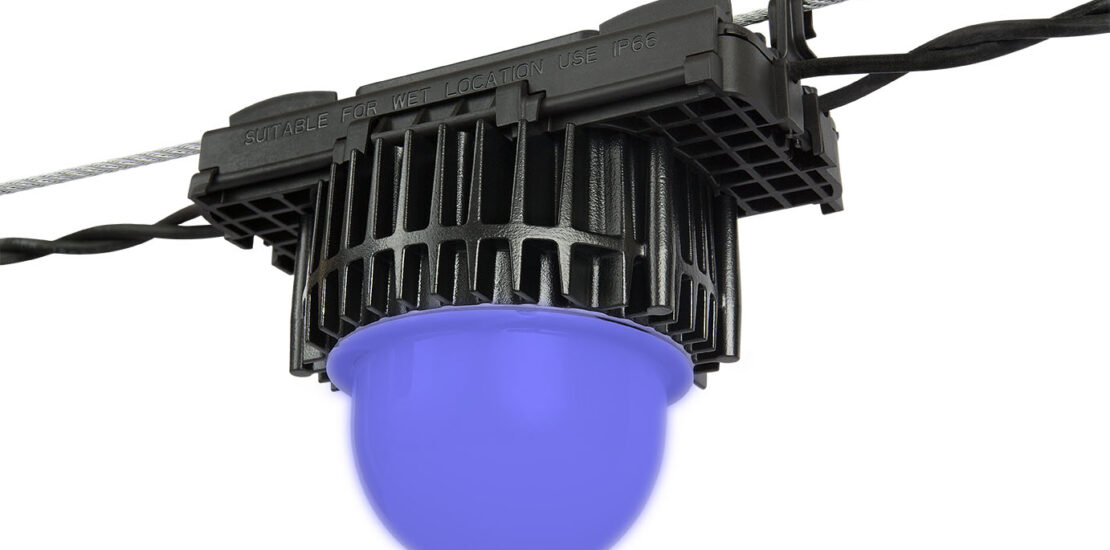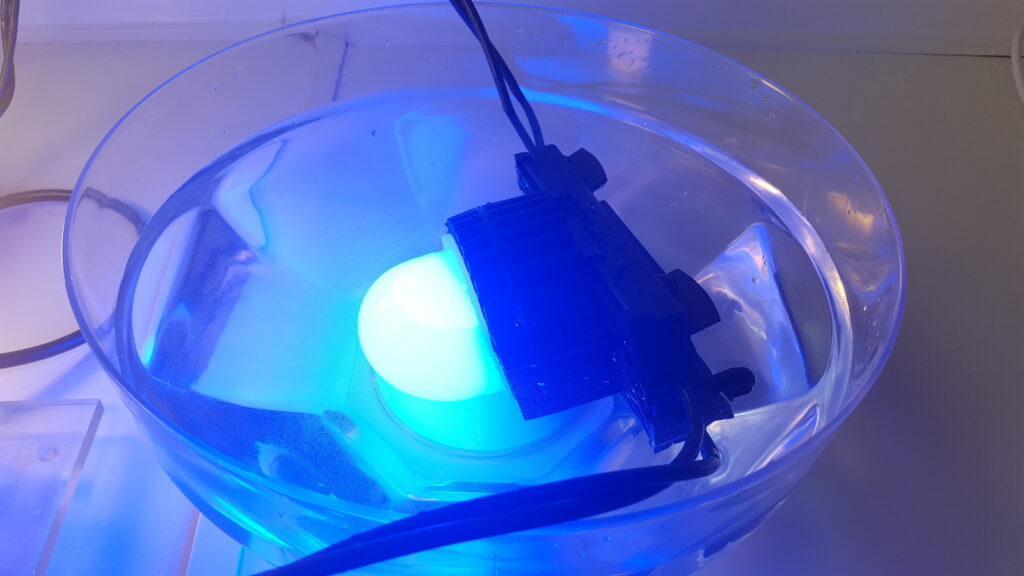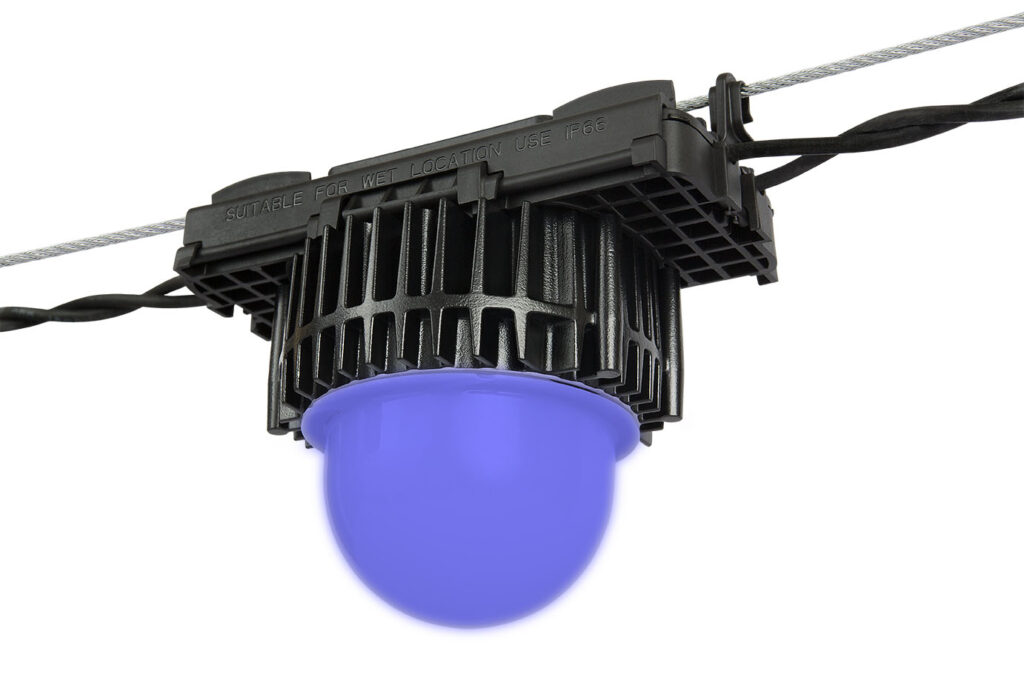- 9 March, 2023
- Posted by: Marketing Manager
- Category: Blog, tips and know-how

Poultry farming is a demanding industry that requires constant attention to detail and the latest technology to ensure maximum productivity and profitability. Over the years, various aspects of the industry such as selection, breeding, feed, medication, vaccination, water management, litter and ventilation have all undergone significant changes and evolved into a highly sophisticated system. One area where technology has also made significant advancements is in lighting systems for poultry barns, with modern poultry-specific lighting systems significantly improving productivity and cutting costs. In their strive to discover the best light spectra for industrial poultry production, scientists have discovered the effect different coloured light has on poutry. In this post we would like to focus on blue lighting and its benefits for commercial poultry production.

What is blue lighting?
Blue lighting is definitely not regarded as a staple for poultry, even poultry specific LED lighting isn’t installed in most farms, let alone blue lights. In these turbulent economic times, farmers may be hesitant to invest in additional expensive equipment that they may view as redundant. However, blue lighting in poultry farming has numerous benefits that make it a smart investment for farmers who want to future-proof their businesses.
Blue lighting is a specialized lighting solution that emits blue light with a wavelength of 440-490 nm. This type of lighting has been shown to have numerous benefits for poultry, including improved growth and development, increased feed efficiency, lower mortality, decreased aggression and stress, better overall health, and welfare.
The key benefits of blue lighting
One of the primary benefits of blue lighting is its effect on growth and development. Research has shown that blue lighting can stimulate growth in poultry, resulting in faster weight gain and higher feed conversion rates. Some studies have found that broilers exposed to blue light had better feed efficiency compared to those exposed to red light or white light, others also explored the benefits of green lighting and green-blue combinations. Environmental manipulation has been noted to be a powerful tool for increasing productivity, so all potential effects were explored.
There’s some evidence to suggest that blue lights might have antimicrobial properties and could be used to minimise infection in flocks. This is an especially promising application, which could tighten biosecurity and mitigate any future danger from disease outbreaks.
Blue lighting can also improve the welfare of poultry by reducing stress levels. In most studies (be it broiler or layer) birds exhibited less feather pecking and aggression under blue lights, their stress hormones were lower too. In layers blue light resulted in lower feather pecking and aggression, increased feed conversion and improved egg production. One known use for blue lights is decreased stress during thinning. Does it have the same effect as a clear blue sky?

Blue light can also help manage heat stress in poultry
According to a 2017 study published in Oxidative Medicine and Cellular Longevity (Safaa E. Abdo et al., 2017), blue light may be an effective tool for mitigating the negative effects of heat stress in broiler production. The study found that blue light exposure reduced oxidative stress and heat shock protein (HSP70) levels in brain, liver, and heart tissues, resulting in improved outcomes for broilers. This benefit is particularly relevant for poultry production in subtropical climates, where heat stress can be a major issue. However, given the recent heatwave in 2022 that affected flocks in traditionally “colder” countries in Europe, such as Germany, Scotland, and Scandinavian countries, the use of blue lighting may also prove to be beneficial in these regions. While there are other methods for dealing with heat stress in poultry, blue lighting offers the added advantage of increasing productivity and welfare in broiler chickens.
Overall, blue lighting has many benefits for poultry farming, including improved growth and development, increased feed efficiency, better health and welfare, increased egg production, and improved behaviour. Investing in this technology can have a significant impact on the productivity and profitability of a poultry farm.
Should you invest in blue lighting?
It is understandable that farmers may be hesitant to invest in expensive equipment, particularly in these turbulent economic times. With uncertainties around the global supply chain, it may seem like a risk to invest in new technology that comes with a hefty price tag. However, it is essential to remember that the goal of any business is to be profitable, and sometimes, that requires taking a calculated risk. If switching to poultry-specific LED lights is in the plans, then adding 20 blue lightbulbs is definitely not going to break the bank and will improve productivity and welfare. For farmers who aren’t quite ready to take the plunge or those considering it in the future – ALIS by Greengage offers a flexible lighting solution.
If you are ready to switch to LED poultry-specific lighting, but you’re not sure if you want colored lights, ALIS is the perfect option. Once your system is installed at any point in time you can buy additional lights and just clip them onto the system. If you don’t like their positioning or if you want to experiment a bit more with the layout – you can always reposition them.

It is important to consider the long-term benefits of investing in new technology, such as blue lighting for poultry. By investing in the latest and most efficient equipment, farmers can improve their productivity, reduce their operating costs, and increase their profitability. For example, if a farmer invests in blue lighting for their poultry barn, they can increase the growth rate of their birds, reduce the risk of disease outbreaks, and improve feed efficiency, which ultimately translates into higher profits.
It is important to recognize that investing in blue lighting for poultry farming can be expensive, and it is a legitimate concern for farmers. However, it is equally important to note that the production boost from blue lights can make the lights pay for themselves very quickly.
According to industry experts, the increased growth rate and improved feed efficiency resulting from blue lighting can lead to a payback period of as little as six months. This means that in just half a year, the investment in blue lighting will have paid for itself through increased productivity and profitability. This is a significant return on investment, and it demonstrates the value of investing in new technology that can improve productivity and profitability.
While the current economic climate may be uncertain, one thing is clear: businesses that embrace high-end technology that helps productivity and efficiency are more likely to survive and thrive in the long term. By investing in the latest technology, such as blue lighting for poultry, farmers can future-proof their businesses and ensure that they remain competitive in an ever-changing market.
In addition to the benefits outlined above, investing in new technology can also help farmers to meet evolving consumer demands. Consumers are increasingly concerned with animal welfare and sustainability, and they are willing to pay a premium for products that meet these criteria. By investing in technology that improves the health and welfare of their birds, reduces environmental impact, and increases efficiency, farmers can position themselves to meet these demands and capture premium prices for their products.

Future-proof and profitable
In conclusion, blue lighting has many benefits for poultry farming, including improved growth and development, increased feed efficiency, better health and welfare, reduced stress, increased heat resilience, and improved behaviour. While it is understandable that farmers may be hesitant to invest in expensive equipment, it is important to consider the long-term benefits of investing in new technology that can improve productivity and profitability. The production boost from blue lights can make the lights pay for themselves very quickly, and embracing high-end tech that helps productivity is futureproofing one’s business. By investing in blue lighting for their poultry barn, farmers can improve their productivity, reduce their operating costs, and increase their profitability, positioning themselves for long-term success in the poultry industry.